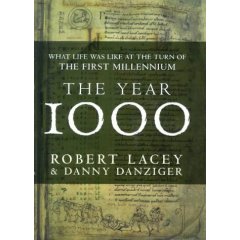Eight years into the new millennium has diminished the novelty of that turn of the calendar. I can’t remember when was the last article or workshop I’ve seen with a reference to how to anticipate and address some concern “in the next millennium†or “in the new millennium.†And I, for one, am glad of it.
Reading history gives perspective and I try to read as much of it as I can. I finally got down the “to-read†books pile deep enough to pull out a book nine years in the waiting. And Robert Lacey’s The Year 1000: What Life Was Like at the Turn of the First Millennium (New York: Little, Brown and Co., 1999) was worth the wait.

Using the Julius Work Calendar (images of the calendar can be found here) as an organizing motif Lacey presents the life of the English (then living in Engla-lond) through a twelve-month cycle. At the start of that millennium Christianity was just starting to plant a firm foot into the life, culture, politics, and religion of the people of Engla-lond. One of the aspects of the book I found fascinating to read in each chapter was about what existed in the year 1000 and what did not yet exist.
Lacey concludes the book,
What C. S. Lewis called the “snobbery of chronology†encourages us to presume that just because we happen to have lived after our ancestors and can read books which give us some account of what happened to them, we must also know better than them. We certainly have more facts at our disposal. We have more wealth, both personal and national, better technology, and infinitely more skilful ways of preserving and extending our lives. But whether we today display more wisdom or common humanity is an open question, and when we look back to discover how people coped with the daily difficulties of existence a thousand years ago, we might also consider whether, in all our sophistication, we could meet the challenges of their world with the same fortitude, good humour, and philosophy.
This is an entertaining and informative reading experience. Highly recommended.


Pingback: Book Reviews